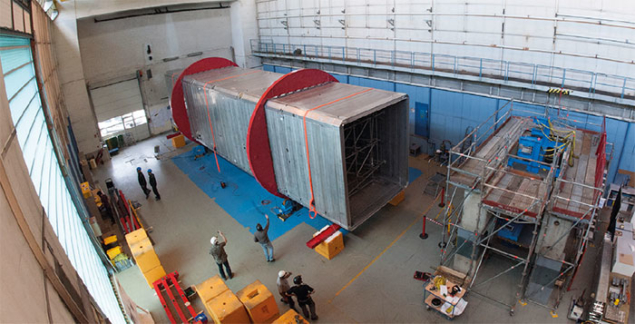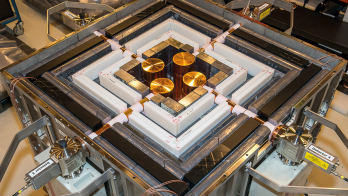
Image credit: CERN.
CERN and Fermilab have a rich history of scientific accomplishment. Fermilab, which is currently the only US laboratory fully devoted to particle physics, tends to favour fermions: the top and bottom quarks were discovered here, as was the tau neutrino. CERN seems to prefer bosons: the W, Z and Higgs bosons were all discovered at the European lab. Both labs also have ambitious plans for the future that build on a history of close collaboration. A recent example is the successful test of a novel high-field quadrupole superconducting magnet made from Nb3Sn as part of the R&D programme for the High-Luminosity Large Hadron Collider (HL-LHC). The highly successful team behind this technology (the Fermilab-led LHC Accelerator Research Programme, which includes Berkeley and Brookhaven national labs) is also committed to developing 16 T magnets for a high-energy LHC and a possible larger circular collider.
Our laboratories and their global communities are now moving even closer together. At a ceremony held at the White House in Washington, DC in May 2015, representatives from the US Department of Energy (DOE), the US National Science Foundation and CERN signed a co-operation agreement for continued joint research in particle physics and computing, both at CERN and in the US. This was followed by a ceremony at CERN in December, at which the US ambassador to the United Nations and the former CERN Director-General signed five formal agreements that will serve as the framework for future US–CERN collaboration. The new agreements enable US scientists to continue their vital contribution to the LHC and its upgrade programme, while for the first time enabling CERN participation in experiments hosted in the US.
The US physics community and DOE are committed to the success of CERN. Physicists migrated from the US to CERN en masse following the 1993 cancellation of the Superconducting Super Collider. In 2008, lack of clarity about the future of US particle physics contributed to budget cuts, which together brought us to a low point for our field. These painful periods taught us that a unified scientific community and strong partnerships are vital to success.
Fortunately, the tides have now turned, in particular thanks to two important planning reports. The first was the 2013 European Strategy Report, which for the first time recommended that CERN supports physics programmes, particularly regarding neutrinos, outside of its laboratory. The following year, this bold proposal led the US Particle Physics Project Prioritisation panel to strongly recommended a continued partnership with CERN on the LHC and to pursue an ambitious long-baseline neutrino programme hosted by Fermilab, for which international participation and contributions are vital.
CERN’s support and European leadership are critical to the success of the ambitious Long-Baseline Neutrino Facility (LBNF) and Deep Underground Neutrino Experiment (DUNE) being hosted by Fermilab. In partnership with the Italian Institute for Nuclear Physics, CERN is also upgrading the ICARUS detector for our short-baseline neutrino programme. Thanks largely to this partnership with CERN, the US particle-physics community is now enjoying a sense of optimism and increasing budgets.
Fermilab and CERN have always worked together at some level, but the high-level agreements between CERN and the DOE will reach decades into the future. CERN recognises the extensive technical capability of Fermilab and the US community, which are currently working to help upgrade CMS and ATLAS as well as accelerator magnets for the HL-LHC, while the US recognises CERN’s leadership in high-energy collider physics, and more than 1000 US physicists call CERN their scientific home.
Yet, not everyone agrees that our laboratories should be intertwined. Some in the US think too much money is sent abroad and believe that the funds could be used for particle physics at “home”, or for other uses entirely. On the other side of the Atlantic, some might wonder why they should work outside of CERN or, worse, outside of Europe. These views are short-sighted. The best science is best achieved through collaborative global partnerships. For this reason, CERN and Fermilab will be intertwined for a long time to come.







